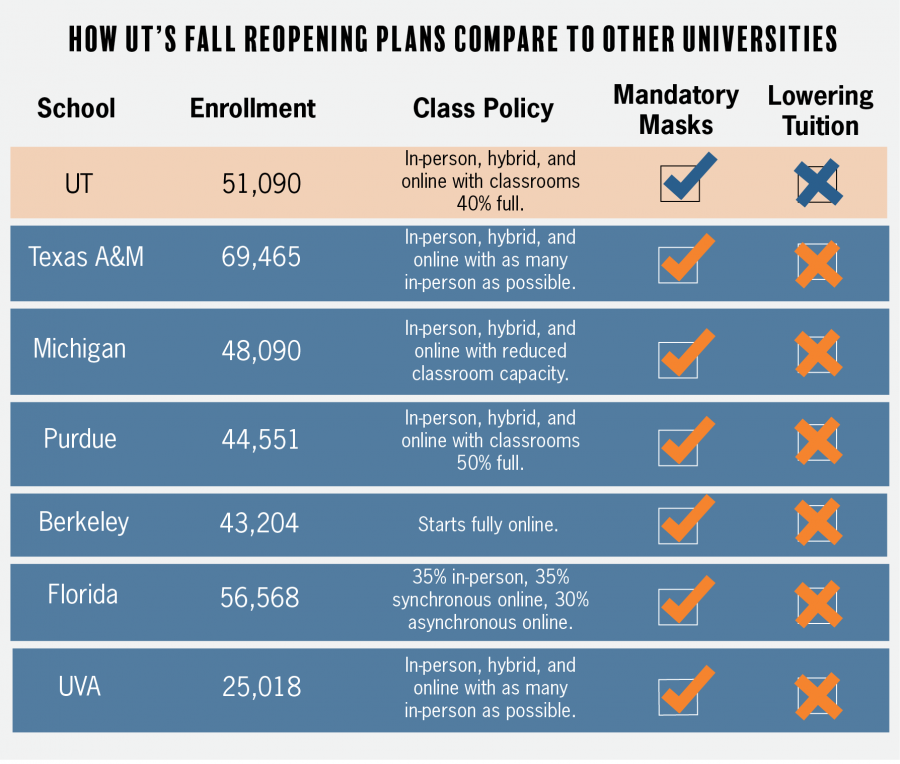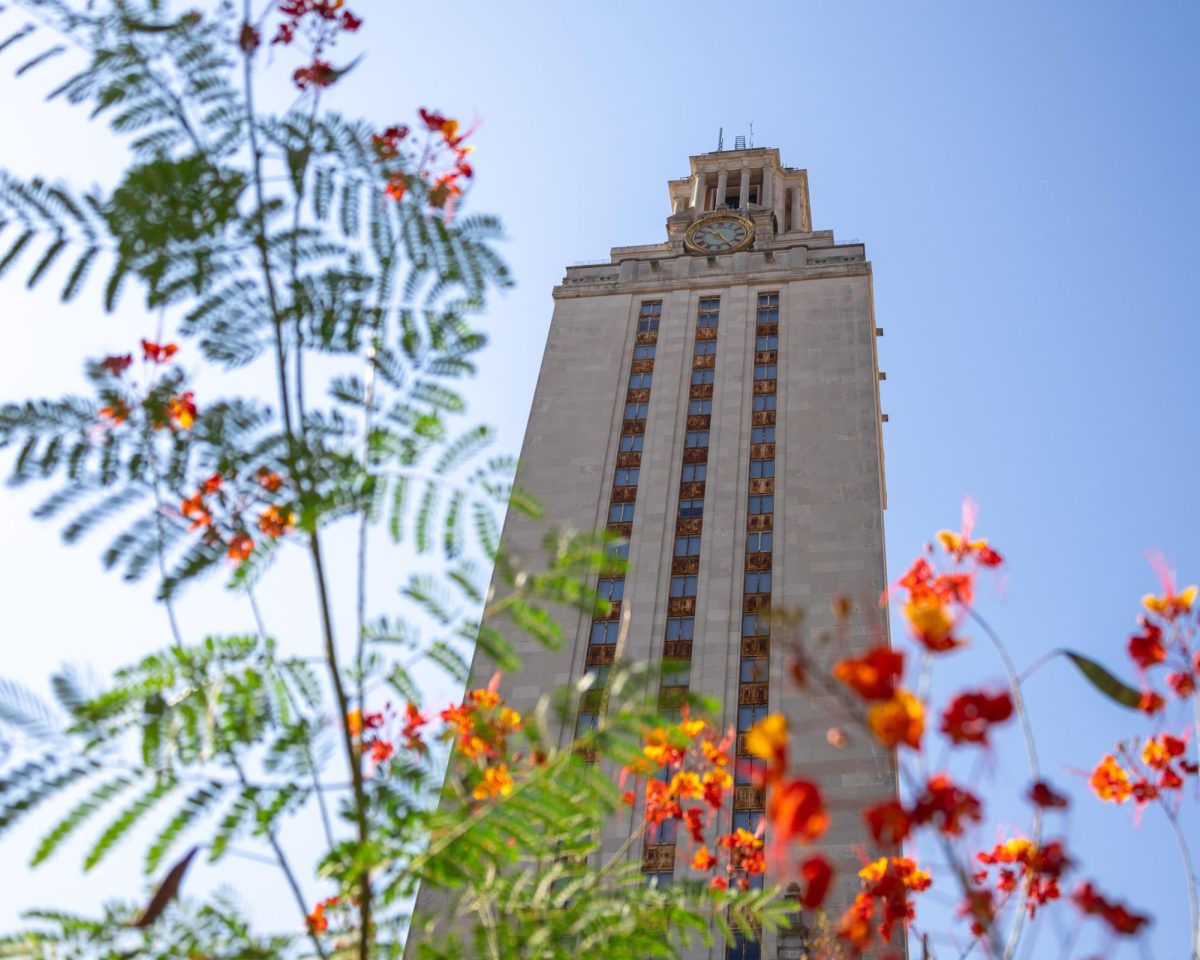Universities across the country are navigating reopening amid the COVID-19 pandemic. As a result, schools have pursued different routes to opening their campuses with plans of in-person classes, testing, housing and more.
Media relations manager Matt Pene said UT-Austin looks closely at what peer institutions are doing for good ideas but does not specifically follow the plans of one university.
UT-Austin enrolled 51,090 students last fall and plans to open this fall with in-person, hybrid and online courses. Not all classes will be offered remotely, and classrooms have a maximum capacity of 40%, according to the Protect Texas Together website.
Face masks will be required in campus buildings, and the University will move fully online after Thanksgiving break.
Students arriving on campus will not be required to take a COVID-19 test, Pene said. The University is offering free, asymptomatic community testing for students, he said.
A COVID-19 test costs $88 at UHS, according to the UHS website. Students without health insurance can receive a subsidy from the University so they can be tested at no cost, Pene said.
As of July 24, 5,058 students have contracts for housing in the fall, said Cynthia Lew, director of marketing and communications for University Housing and Dining. UHD will offer housing in single and double occupancy. Dining halls will be open in a limited capacity.
Austin has seen a recent spike in COVID-19 cases. As of July 26, Travis County has confirmed more than 19,400 COVID-19 cases among its population of 1.27 million, according to the Travis County COVID-19 dashboard.
To get a better sense of how UT-Austin’s fall reopening plan compares to those of other institutions across the country, The Daily Texan took a look at six other large public universities’ approaches for the upcoming school year.
Texas A&M University
Texas A&M University, which enrolled 69,465 students last fall, aims to allow every student to have at least one in-person class this fall with all classes having a remote option, according to the university website. Currently, 50% of classes are face-to-face and more than 60% of students have two or more courses face to face, TAMU spokesperson Kelly Brown said. Face coverings have been required on campus since June 15.
The university has extended their school day schedule to include a midday cleaning break for high-traffic areas, and classrooms will be cleaned during passing periods, according to the website. The university will finish instruction before Thanksgiving and administer finals remotely.
The university will provide free tests to those with symptoms or confirmed exposure to the virus, Brown said. Asymptomatic students will not have access to free tests.
The university will charge all students the same tuition rate. TAMU usually charges a fee for distance education, which will be waived this fall, according to the website.
On-campus housing at the university “will be open and fully operational for fall 2020.” Dining halls will be open in limited capacity in accordance with state guidance, Brown said.
The university is located in Brazos County, which has had more than 3,600 COVID-19 cases in its population of about 230,000 as of July 26, according to the Texas COVID-19 dashboard.
University of California, Berkeley
The University of California, Berkeley, which enrolled 43,204 students last fall, announced July 21 that the fall semester will start fully online, citing “trend lines regarding COVID-19 positive cases” in the region and state, according to a July 21 news release.
Tuition will remain the same for all classes, according to an April news release.
University residence halls will only offer single occupancy rooms, according to the university housing website. Students living in dorms must be tested for COVID-19 upon arrival, isolate for seven to 10 days, and then be tested again. Dining hall food will only be available to go. Face coverings have been required on campus since April 21, according to a news release.
The university is located in Alameda County, which has seen more than 10,300 positive cases, according to the Alameda County Public Health Department. The county has averaged 156 new COVID-19 cases a day out of its population of almost 1.7 million as of July 26, according to the Los Angeles Times’ COVID-19 tracker.
Janet Gilmore, senior director of strategic communications for the university, declined to comment.
University of Michigan, Ann Arbor
The University of Michigan, which enrolled 48,090 students last fall, plans to have large classes online, small classes in person and medium-sized classes as hybrids, according to the university’s Campus Blueprint website. The school will eliminate fall break, and all classes will be delivered remotely after Thanksgiving. Face masks have been required on campus since July 15, according to The Michigan Daily.
Tuition will remain the same, regardless of class delivery, according to the university website.
The university is planning to test all asymptomatic students and looking to partner with sororities, fraternities and large off-campus housing providers for testing, Michigan President Mark Schlissel said in a recent town hall.
Most students living on campus will live in “shared rooms” with communal bathrooms, according to the Michigan Housing website.
The university is located in Washtenaw County, which has had more than 2,300 COVID-19 cases among its population of about 370,000 as of July 24, according to the Washtenaw County COVID-19 dashboard.
Purdue University
Purdue University, which enrolled 44,551 students last fall, will deliver classes in person, hybrid and online, according to the Protect Purdue website. Most classrooms will have capacity reduced by about 50%. Purdue will skip normal fall and holiday breaks and end in-person instruction before Thanksgiving.
Masks have been required on campus since May 26, according to a news release. Residence halls are being de-densified so less students are living in a space, according to the university housing website. Dining halls will start the year offering food to go only and will gradually open dine-in seating areas.
All students taking in-person classes or moving into residence halls must get tested for COVID-19, according to the Protect Purdue website. Students, faculty and staff must also obtain flu vaccination and participate in training exercises. The university plans to work with off-campus landlords to support adherence to public health procedures, according to the Protect Purdue Plan.
Purdue is located in Tippecanoe County, which has had more than 970 COVID-19 cases in its population of about 200,000 as of July 26, according to the Indiana COVID-19 dashboard.
University of Florida
The University of Florida, which enrolled 56,568 students last fall, will have 35% of its classes in-person, 35% synchronously online and 30% asynchronously online, university spokesperson Steve Orlando said. Classroom capacity will be decreased by 80%, he said.
Tuition will be the same for in-person and online classes, according to the university COVID-19 website.
Student groups, including sororities and fraternities, wishing to be active in the fall are required to submit plans to the university for approval, according to the website.
All students are required to undergo symptom screening upon arrival, according to the website. Students who arrive from high-risk areas, work in research or participate in clinicals must undergo COVID-19 testing, according to the university reopening plan.
On-campus housing will open with no triple occupancy rooms, according to the university reopening plan. Dining halls will open with limited in-person seating.
The university is trying to make student life as normal as possible, Orlando said.
The university is located in Alachua County, which has had more than 3,100 COVID-19 cases in its population of about 270,000 as of July 26, according to the Alachua County COVID-19 dashboard.
University of Virginia
The University of Virginia, which enrolled 25,018 students last fall, will deliver courses in online and in-person formats, with the goal of having as many in-person classes as possible, according to the UVA Return to Grounds website. All classes will have an online option. In-person instruction will end at Thanksgiving, and all final exams will be online.
Masks will be required on campus, according to the website.
All students who plan to return to campus are required to take a COVID-19 test, which the university will pay for, according to the website. Students will have to submit a daily health screening via app or email.
Incoming students living in on-campus housing will live in double occupancy rooms by default, according to the website. Dining halls will open at 50% capacity.
Student organizations will have to adhere to the same physical distancing limitations as classes, university spokesperson Brian Coy said.
Tuition will be the same for in-person and online instruction, according to the website.
The university is located in Albemarle County, which has had more than 700 COVID-19 cases in its population of about 110,000 as of July 26, according to the Virginia COVID-19 dashboard.





















